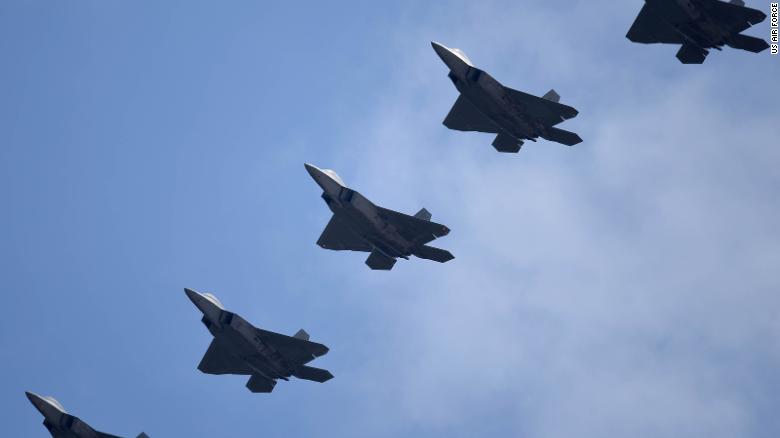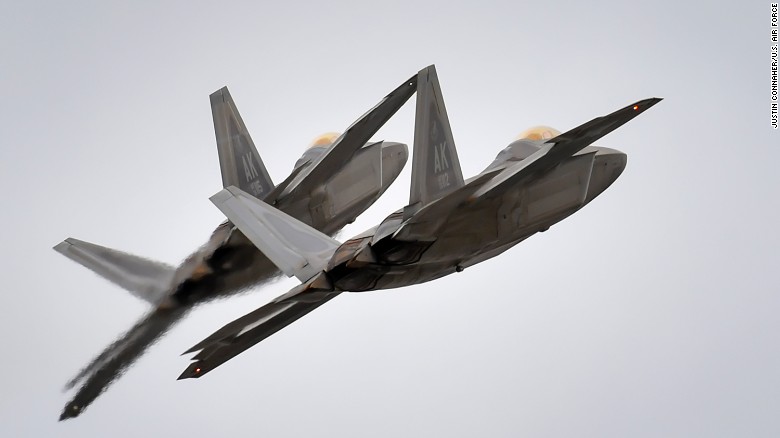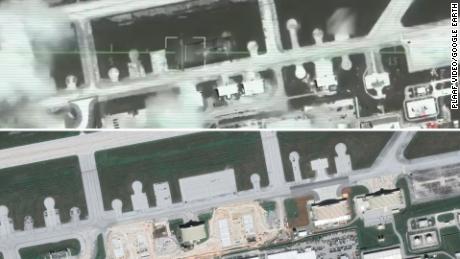US Air Force to send dozens of F-22 fighter jets to the Pacific amid tensions with China

By Brad Lendon, CNN
Updated 1:18 AM ET, Fri July 16, 2021

US Air Force F-22 Raptors fly in formation over Altus Air Force Base in Oklahoma on April 17, 2017.
Hong Kong (CNN)The United States Air Force is sending more than two dozen F-22 stealth fighters to an exercise in the western Pacific this month, an unusually large deployment of the powerful jets that analysts say sends a strong message to a possible adversary in China.
Pacific Air Forces in Hawaii this week said approximately 25 F-22s Raptors from the Hawaii Air National Guard and from Joint Base Elmendorf-Richardson, Alaska, will deploy this month to Guam and Tinian islands for Operation Pacific Iron 2021.
"We have never had this many Raptors deployed together in the Pacific Air Forces area of operations," Gen. Ken Wilsbach, Pacific Air Forces commander, told CNN.
The F-22s are fifth-generation combat jets, the world's most advanced fighter aircraft, incorporating stealth technologies and connecting on-board sensor systems with off-board information systems to give their pilots a detailed view of the battle space. US F-35s are another example.

Two US Air Force F-22 Raptors fly over Alaska in 2016.
Deploying a large number of F-22s for the exercise sends an immediate message to China at a time when relations are tense over Pacific flashpoints like Taiwan and the South China Sea, said Carl Schuster, a Hawaii-based defense analyst and a former director of operations at the US Pacific Command's Joint Intelligence Center. Normal F-22 deployments consist of six to 12 aircraft, he said.
"The Pacific Air Force is demonstrating that it can deploy as many or more fifth-generation aircraft into the theater on short notice than (China) currently has in its entire inventory," he said.

Did China use Hollywood movies in military propaganda clip? (2020) 01:16
The Chinese air force has about 20 to 24 operational fifth-generation fighters, Schuster said, but he noted Beijing's capabilities are improving at a rapid pace.
The US Air Force has around 180 F-22s in its fleet, although only about half are mission capable at any one time due to maintenance requirements, according to Air Force statistics. So the US will be sending about 25% of mission F-22s to the Pacific Iron exercise.
Because of their ability to evade radar detection, F-22s would be expected to be among the first weapons used in any conflict, tasked with taking out an adversary's air defenses among other missions.
"The US is actively practicing the deployments it will make if there is a major crisis or war. The US is taking China very seriously and is developing its force posture and training its forces to be able to quickly move into position," said Peter Layton, a former Australian air force officer now an analyst with the Griffith Asia Institute.

A US Air Force F-22 Raptor lines up next to three F-15E Strike Eagles at Royal Air Force Lakenheath, England, in 2017.
For Operation Pacific Iron, 10 F-15 Strike Eagle fighters from Mountain Home Air Force Base in Idaho and two C-130J Hercules transport planes from Yokota Air Base in Japan will join the F-22s to fill out the air fleet for what the Air Force calls an Agile Combat Employment operation, also referred to as a combat dispersal operation, according to a statement from Pacific Air Forces.
The exercise is in support of the 2018 National Defense Strategy, "which called on the military to be a more lethal, adaptive, and resilient force," the statement said.
Agile Combat Employment is designed to spread US combat planes and other warfighting assets among airfields across the region to increase their survivability from enemy missile strikes.

Dramatic videos show Chinese naval exercises amid rising tensions over Taiwan (April 2021) 04:04
For instance, much of the US combat air power in the western Pacific is concentrated on large military installations like Kadena Air Base on Okinawa or Andersen Air Force Base on Guam. A strike on those bases could cripple the US military's ability to hit back at an adversary if too much US air power was concentrated there.
In Pacific Iron, the forces will practice from smaller, less developed airfields like Tinian International Airport on the island in the Northern Marianas, Won Pat Intenational Airport on Guam or Northwest Field, a remote strip separate from the main runways of Andersen Air Force Base. Lessons learned in the exercise could be applied to operating from smaller airports on islands around the western Pacific.
That would increase the number of targets enemy missiles would need to destroy and give US air power a better chance of being able to fight back.
A 2019 report from the RAND Corp think tank, funded by the US military, shows how the concept is envisioned to counter growing Chinese capabilities .
China's People's Liberation Army "possesses a growing quantity and quality of long-range precision cruise and ballistic missiles that can threaten key targets on air bases," the report says.
"Distributing aircraft across more locations improves survivability; an adversary must fire more missiles to achieve the same effect," it says.

China releases video of 'Guam killer' missile 01:01
"Demonstrating the US Air Force's Agile Combat capability sends a strong deterrent signal to China and reassuring one to (US) allies and partners," Schuster said.
"China will try to follow it closely," he said.
Layton, the Australian analyst, said using the F-22 presents the US Air Force with some degree of difficulty.
"The F-22 is one of the more difficult aircraft for this kind of deployment exercise in terms of mission and maintenance support. If you can do this with the F-22 then doing it with any other US tactical fight aircraft should be straightforward," Layton said.
Wilsbach, the Pacific Air Forces commander, called Pacific Iron "one of the most complex deployments we have ever organized."
"We can move forces and capabilities around the globe at will, but it's what they do when we bring these capabilities together that matters most," the general said.
A successful exercise would have deterrent value toward China, said Layton..
"While this is an exercise, the same techniques, processes and procedures would be crucial in operations from Japan or elsewhere. For Chinese military planners it might suggest such F-22 force packages could be deployed to anywhere around China's periphery," Layton said.

US Air Force airmen perform hot-pit refueling on an F-35A fighter at Northwest Field as part of an Agile Combat Employment (ACE) on Guam in February.
The Air Force used Guam's Northwest Field to practice Agile Combat Employment operations in February, refueling both F-35 and F-16 fighter jets that were unable to return to their home bases in a simulated combat situation.
Air Force Tech. Sgt. Todd Johnson, who participated in the February exercise, used a sports analogy to describe the concept.
"Think of it like a pit stop in NASCAR. If you have a well-trained and organized team, then a jet will be able to land, get a safety check, get refueled and ready to get back in the sky in just minutes," he said in an Air Force press release on that exercise.
Will pregnant pilots be flying them too lol?
ReplyDeleteWhat does pregnancy have to do with the price of Tea in China?
DeleteEverything......
DeleteThe Chinese have more and will overwhelm us........
ReplyDelete